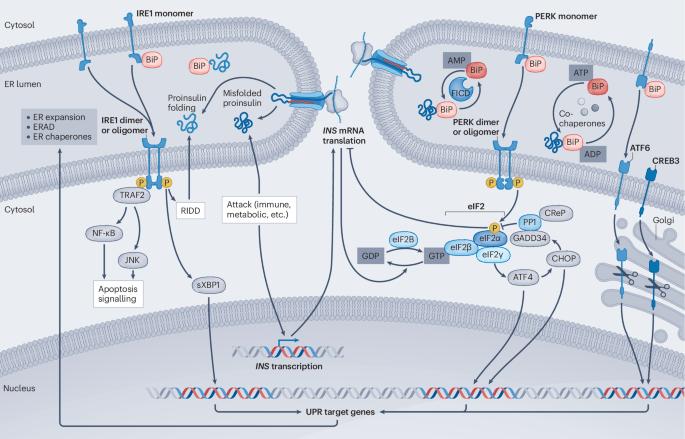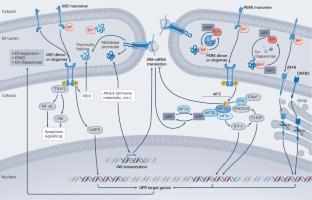Diabetes mellitus and the key role of endoplasmic reticulum stress in pancreatic β cells
IF 40
1区 医学
Q1 ENDOCRINOLOGY & METABOLISM
引用次数: 0
Abstract
Insufficient insulin secretion by pancreatic β cells is central to the pathogenesis of diabetes mellitus. As insulin is synthesized in the endoplasmic reticulum (ER), perturbations in ER homeostasis lead to ER stress and activate the ER stress response. Over the past two decades, considerable data have accumulated on the role of β cell ER stress in diabetes mellitus. Several monogenic forms of diabetes mellitus are caused by excessive ER stress, perturbed ER stress response signalling or impaired ER–Golgi protein trafficking. These pathways are now recognized to contribute to β cell failure in both type 1 and type 2 diabetes mellitus. This Review considers the role of β cell ER stress in common forms of diabetes mellitus and examines whether it is a cause or a consequence of these diseases. The strong genetic evidence for a causal role of ER stress in 15 monogenic forms of diabetes mellitus is summarized, and the effects of ER stress on human β cell differentiation, function and survival are described. Although definitive proof is lacking that ER stress responses can be therapeutically targeted to improve β cell function in diabetes mellitus, existing and novel treatments that aim to restore ER homeostasis are also outlined. Genetic mutations and environmental exposures cause severe endoplasmic reticulum (ER) stress in pancreatic β cells, which can culminate in diabetes mellitus. Lytrivi et al. describe the causes and consequences of ER stress for β cell development, function and survival, and debate emerging therapeutic approaches.


糖尿病与胰岛β细胞内质网应激的关键作用
胰岛β细胞分泌胰岛素不足是糖尿病发病的核心。由于胰岛素是在内质网(ER)中合成的,内质网稳态的扰动导致内质网应激并激活内质网应激反应。在过去的二十年中,积累了大量关于β细胞内质网应激在糖尿病中的作用的数据。几种单基因型糖尿病是由内质网应激过度、内质网应激反应信号紊乱或内质网-高尔基体蛋白运输受损引起的。这些途径现在被认为有助于1型和2型糖尿病的β细胞衰竭。这篇综述考虑了β细胞内质网应激在常见形式糖尿病中的作用,并探讨了它是这些疾病的原因还是结果。本文总结了内质网应激在15种单基因型糖尿病中起因果作用的强有力的遗传证据,并描述了内质网应激对人β细胞分化、功能和生存的影响。虽然缺乏明确的证据表明内质网应激反应可以改善糖尿病患者的β细胞功能,但也概述了旨在恢复内质网稳态的现有和新的治疗方法。
本文章由计算机程序翻译,如有差异,请以英文原文为准。
求助全文
约1分钟内获得全文
求助全文
来源期刊

Nature Reviews Endocrinology
医学-内分泌学与代谢
CiteScore
42.00
自引率
0.70%
发文量
158
审稿时长
6-12 weeks
期刊介绍:
Nature Reviews Endocrinology aspires to be the foremost platform for reviews and commentaries catering to the scientific communities it serves. The journal aims to publish articles characterized by authority, accessibility, and clarity, enhanced with easily understandable figures, tables, and other visual aids. The goal is to offer an unparalleled service to authors, referees, and readers, striving to maximize the usefulness and impact of each article. Nature Reviews Endocrinology publishes Research Highlights, Comments, News & Views, Reviews, Consensus Statements, and Perspectives relevant to researchers and clinicians in the fields of endocrinology and metabolism. Its broad scope ensures that the work it publishes reaches the widest possible audience.
 求助内容:
求助内容: 应助结果提醒方式:
应助结果提醒方式:


